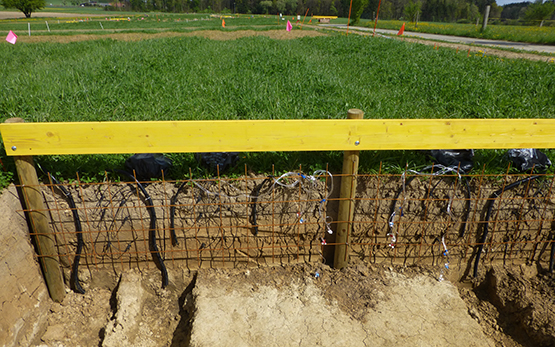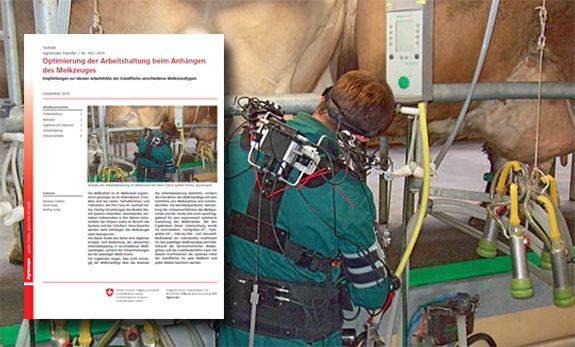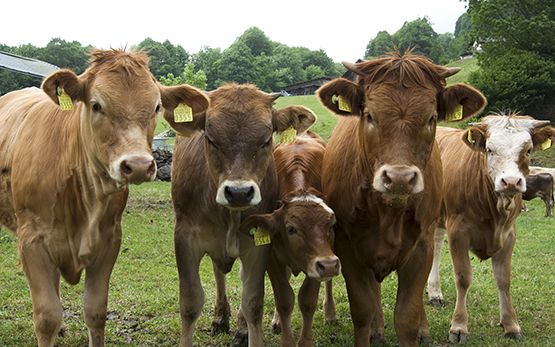Lindtke D., Seefried F. R., Drögemüller C., Neuditschko M.
Increased heterozygosity in low‐pass sequencing data allows identification of blood chimeras in cattle.
Animal Genetics, 54, (5), 2024, 613-618.
Démoulins T., Yimthin T., Lindtke D., Eggerschwiler L., Siegenthaler R., Labroussaa F., Jores J.
Temperature impacts the bovine ex vivo immune response towards Mycoplasmopsis bovis.
Veterinary Research, 55, 2024, 1-22.
Gmel A., Haraldsdóttir E., Serra Bragança F., Cruz A., Weishaupt M.
Comparison of speed-dependent time, force and spatial parameters between Franches-Montagnes and European Warmblood horses walking and trotting on a treadmill.
Journal of Equine Veterinary Science, 133, (February), 2024, 1-11.
Mbuthia J., Kasper-Völkl C., Zenk M., Bee G., Metges C., Das G.
Prediction of piglet survival based only on birth weight or within-litter birth weight variability.
Dans: Book of Abstracts of the 74th Annual Meeting of the European Federation of Animal Science. 26 August - 1 September, Ed. EAAP European Federation of Animal Science, Lyon (FR). 2023, 214.
Kasper-Völkl C., Schori F., Ampuero S., Hayoz B., Siegenthaler R., Eggerschwiler L.
The genetic background of nitrogen use efficiency and methane emissions in Swiss dairy cows: Ongoing activities at Agroscope.
Dans: Agro-Vet Strickhof-Tagung. 7. November, Lindau. 2023, 1.
Kasper-Völkl C., Lepori A., Gutiérrez J. P., Formoso-Rafferty N., Sell-Kubiak E., Cervantes I.
Breeding for uniformity in piglet birth weight to improve survival.
Dans: Book of Abstracts of the 74th Annual Meeting of the European Federation of Animal Science. Ed. EAAP European Federation of Animal Science, 2023, 210.
Kasper-Völkl C., Lepori A., Gutiérrez J. P., Formoso-Rafferty N., Sell-Kubiak E., Cervantes I.
Genetic parameters for genetic variance uniformity in Swiss pigs’ birth weight.
Dans: Book of Abstracts of the 74th Annual Meeting of the European Federation of Animal Science. Ed. EAAP European Federation of Animal Science, 2023, 204.
Gmel A., Stefaniuk-Szmukier M., Klecel W., Martin-Gimenez T., Cruz A., Weishaupt M.
Differences in joint angles from photographs between six European breeds: Preliminary results.
Dans: The 9th International Conference on Canine and Equine Locomotion. 30. August, Utrecht (NL). 2023, S14.
Gmel A., Haraldsdottir E., Neuditschko M., Weishaupt M.
Differences in gait quality parameters between Franches-Montagnes and Swiss Warmblood horses.
Dans: The 9th International Conference on Canine and Equine Locomotion. 30. August, Utrecht (NL). 2023, 14.
Kasper-Völkl C., Lepori A., Gutiérrez J.P., Formoso-Rafferty N., Sell-Kubiak E., Cervantes I.
Breeding for uniformity in piglet birth weight to improve survival.
Dans: EAAP. 27 August, Lyon. 2023, 1.
Kasper-Völkl C., Lepori A., Gutiérrez J.P., Formoso-Rafferty N., Sell-Kubiak E., Cervantes I.
Genetic parameters for genetic variance uniformity in Swiss pigs’ birth weight.
Dans: EAAP. 27 August, Lyon. 2023, 1-16.
Kasper-Völkl C., Schori F., Ampuero S.
Current study investigating the genetic background of nitrogen use efficiency and methane emissions in Swiss dairy cows.
Dans: Interbull Meeting. 26. August, Lyon. 2023, 1-14.
Roch L., Ewaoluwagbemiga E., Kasper-Völkl C.
Phenotypic link between protein efficiency and pig welfare suggests no apparent trade-offs for mitigating nitrogen pollution.
Scientific Reports, 13, 2023, 1-13.
Kasper-Völkl C., Schori F., Ampuero S., Hayoz B., Siegenthaler R., Eggerschwiler L.
Ongoing research to investigate the genetic background of nitrogen use efficiency and methane emissions of Swiss dairy cows.
Dans: ICAR Meeting. 24. May, Toledo. 2023.
Ewaoluwagbemiga E., Bee G., Kasper-Völkl C.
Genetic analysis of protein efciency and its association with performance and meat quality traits under a protein-restricted diet.
Genetics Selection Evolution, 55, 2023, 1-16.
Roch L., Ewaoluwagbemiga E., Kasper-Völkl C.
Social interactions, precursors of damaging behaviours, object manipulation, straw rooting, and activity: A detailed data set in undocked pigs under protein restriction.
Animal Open Space, 2, 2023, 1-7.
Gmel A., Brem G., Neuditschko M.
New genomic insights into the conformation of Lipizzan horses.
Scientific Reports, 13, 2023, 1-9.
Kasper-Völkl C., Schori F., Ampuero S., Hayoz B., Siegenthaler R., Eggerschwiler L.
Laufende Untersuchungen zu genetischen Grundlagen von Stickstoffnutzungseffizienz und Methanemissionen von Schweizer Milchkühen.
Dans: Spring Conference 2023. 19.April, Ed. SCHWEIZERISCHE VEREINIGUNG FÜR TIERWISSENSCHAFTEN, Zollikofen. 2023, 1.
Kasper-Völkl C., Schori F., Ampuero S., Hayoz B., Siegenthaler R., Eggerschwiler L.
Laufende Untersuchungen zu genetischen Grundlagen von Stickstoffnutzungseffizienz und Methanemissionen von Schweizer Milchkühen.
Dans: Schweizerische Vereinigung für Tierwissenschaften-Tagung 2023. 19. April, Ed. HAFL, Zollikofen. 2023.
Gmel A., Guichard M., Dainat B., Rhys Williams G., Eynard S., Vignal A., Servin B., the Beestrong Consortium, Neuditschko M.
Identification of runs of homozygosity in Western honey bees (Apis mellifera) using whole-genome sequencing data.
Ecology and Evolution, 13, (1), 2023, 1-13.
Parmentier J. I. M., Bosch S., van der Zwaag B. J., Weishaupt M. A., Gmel A. I., Havinga P. J. M., van Weeren P. R., Serra Braganca F. M.
Prediction of continuous and discrete kinetic parameters in horses from inertial measurement units data using recurrent artificial neural networks.
Scientific Reports, 13, 2023, 1-14.
Couteller L., Roch L., Kasper-Völkl C.
Distinctive gene-expression profiles characterise tail-biting precursors in pigs under dietary protein restriction.
Dans: Proceeding of 12th World Congress on Genetics Applied to Livestock Production (WCGALP). Ed. Wageningen Academic Publishers, Wageningen (Netherlands). 2023, 3270-3273.
Pick J. L., Kasper-Völkl C., Allegue H., Dingemanse N. J., Dochtermann N. A., Laskowski K. L., Lima M. R., Schielzeth H., Westneat D.F., Wright J., Araya-Ajoy Y. G.
Describing posterior distributions of variance components: Problems and the use of null distributions to aid interpretation.
Methods in Ecology and Evolution, Preprint, 2023.
Ewaoluwagbemiga E., Bee G., Kasper-Völkl C.
Protein efficiency is heritable but not genetically correlated with meat quality in pigs.
Dans: Proceeding of 12th World Congress on Genetics Applied to Livestock Production (WCGALP). Wageningen Academic Publishers. 2022, 352-355.
Gmel A., Haraldsdóttir E. H., Bragança F. M. S., Cruz A. M., Neuditschko M., Weishaupt M. A.
Determining objective parameters to assess gait quality in Franches-montagnes horses for ground coverage and over-tracking: Part 2: At trot.
Journal of Equine Veterinary Science, 120, 2022, 1-9.
Couteller L., Roch L., Kasper-Völkl C.
Tail biting and its precursors have distinctive gene-expression profiles in protein-restricted pigs.
Dans: 73rd Annual Meeting of the European Federation of Animal Science. 5-9 September, Ed. EAAP, Porto. 2022, 325.
Gmel A., Burren A., Neuditschko M.
Estimates of Genetic Parameters for Shape Space Data in Franches-Montagnes Horses.
Animals, 12, (17), 2022, 1-16.
Couteller L., Roch L., Kasper-Völkl C.
Tail biting and its precursors have distinctive gene-expression profiles in protein-restricted pigs.
Dans: EAAP-Konferenz. 06. September, Porto. 2022.
Couteller L., Roch L., Kasper-Völkl C.
Distinctive gene-expression profiles characterise tail-biting precursors in pigs under dietary protein restriction.
Dans: World Congress on Genetics Applied to Livestock Production. 08. Juli, Rotterdam. 2022.
Ewaoluwagbemiga E., Bee G., Kasper-Völkl C.
Protein efficiency is heritable but not genetically correlated with meat quality traits in pigs.
Dans: World Congress on Genetics Applied to Livestock Production. 04. Juli, Rotterdam. 2022.
Gmel A., Haraldsdottir E., Serra Bragança F., Cruz A., Neuditschko M., Weishaupt M.
Determining objective parameters to assess gait quality in Franches-Montagnes horses for ground coverage and over-tracking: Part 1: At walk.
Journal of Equine Veterinary Science, 115, 2022, 1-10.
Roepstorff C., Gmel A. I., Arpagaus S., Serra Bragança F. M., Hernlund E., Rhodin M., Roepstorff L., Weishaupt M. A.
Modelling fore- and hindlimb peak vertical force differences in trotting horses using upper body kinematic asymmetry variables.
Journal of Biomechanics, 137, (May), 2022, 1-11.
Gmel A. I., Gmel G., Weishaupt M. A., Neuditschko M.
Gait quality scoring data of Franches-Montagnes stallions at walk and trot on a treadmill by experts of the breed and their reliability.
Data in Brief, 42, 2022, 1-11.








